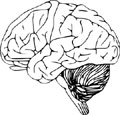
 Brain & Senses Brain & Senses
Your brain is the most complex part of your body, it performs a large number of amazing calculations every second, taking in information from the outside world in the form of senses and allowing you to quickly respond to various situations. Use this senses lesson plan to show students some fun brain activities and teach them more about brain functions such as memory, taste, sight and touch.
|
|
|
Introduction:
-
It is said that as far back as 10000 years ago people had a strong awareness of the importance of the head and brain.
-
The word ‘brain’ originated from the ancient Egyptians.
-
Early philosophers such as Socrates and Aristotle wrote and made theories regarding the human brain although Aristotle also believed that the heart played a crucial role in human intelligence.
-
The human brain interprets the world around us in many different ways. These processes are researched in the study of neuroscience.
-
Can you name some of the ways that humans process information from the world around us? Memory, reflexes, senses etc.
-
If you have access to old human and animal skulls they are great for giving a physical perspective. Ask the students for any differences or similarities they notice between them. Good posters and images are also useful, you explain what scientists already know about the human skull and brain.
-
Physical differences in the brain of different species go much deeper than the obvious size and shape aspects, feel free to discuss more about this, the senses and brain functions in general.
Sight Activity:
- Another way that our brains make assumptions is through optical illusions. Our brain tries to fill in the gaps, especially as we have been taught to use specific shapes and angles to tell us about size. Your brain is always looking for blank spaces and filling them with information. Our brains are always trying to recognise things in our environment and create meaning out of them. It is part of our survival instinct. Sometimes your brain leaps to the wrong conclusion and you get a surprise. Magicians and illusionists are experts at using this to their advantage.
Taste Activity:
- Show the students a colored jellybean, red for example. They have to guess what flavour it might be. After they have guessed, give them all one of these jellybeans and see if they were right. Talk to them about how our brain sometimes makes assumptions about certain things that we have a memory of.
Memory Activity:
- Test the short term memory of the students. Show them a number of different objects and tell them to remember as many as possible. They have only one minute to look at them. Hide the objects after one minute has passed. Let the kids write down as many things as they can remember on a sheet of paper. Can they remember all of the items? Are there any that were forgotten by everyone? What could they do to improve their memory?
Touch Activity:
What areas of our bodies are most sensitive to touch? Our Hands? Feet? Fingers?
-
Bend a paper clip into the shape of a U with the tips about 2 cm apart. Make sure the tips of the U are evenly aligned with each other.
-
Lightly touch the two ends of the paper clip on the back of your partners hand. Your partner should not be looking as you do this. Do not press to hard!
-
Try and make sure that both tips touch the skin at the same time. Ask your partner if they felt one or two pressure points.
-
If your partner felt one point, spread the tips of the clip a bit further apart, then touch the back of your partners hand again. If your partner felt two points, push the tips a bit closer together and test again.
-
Measure the distance at which your partner can feel two points.
-
Now try the same thing on different parts of the body and record the distances.
What's happening?
The receptors in our skin are not distributed in a uniform way around our body. Some places, such as our finger and lips, have more touch receptors than other parts of our body, such as our backs. That is one reason why we are more sensitive to touch on our fingers and face than on our backs.
|
|